Toward a Low-Carbon Transport Sector in Mexico
Abstract
1. Introduction
2. Mexican Transport Sector Current Situation
3. General Methodology
- The year 2010 is established as the reference year, since for that year it was possible to combine all the information needed to represent the Mexican transport sector demand, especially because for this year, the road transport fleet by vehicle type and its survival curves data were available [26], which facilitated the BLS development.
- A BLS is constructed for the period 2011–2035, in which the amount of the most consumed energy carriers, gasoline and diesel, is estimated through an evolution model of the road transport vehicle fleet. Meanwhile, for other transport fuels or energy carriers used, such as kerosene, fuel oil, electricity, natural gas, and liquefied petroleum gas (LPG), their future consumption in this sector is estimated assuming the official consumption prospective of each of these fuels [27,28]. Subsequently, the annual CO2 emissions are calculated for each of the fuels mentioned in the BLS.
- A low carbon scenario (LCS) is constructed with the 21 mitigation measures, as will be described in the section covering the LCS construction, where the main assumptions are stated.
- Finally, a cost-benefit analysis is carried out to determine the economic viability of the LCS scenario in relation to the BLS scenario. Table 2 shows the fuels levelized prices assumed to be representative of fuels price evolution between 2011–2035 which were incorporated into our calculations in Excel spreadsheets as constants. Last column shows fuel’s information sources. All monetary values in this study are expressed in constant year 2007 US dollars (USD).
3.1. Methodology Development in Excel Spreadsheets
- The vehicle stock was classified according to the following vehicle types: Light Duty Vehicles (LDV): subcompact, compact, luxury and sport cars, SUVs and light trucks all gasoline vehicles, and Heavy Freight Vehicles (HDV): freight transport and passenger buses that use diesel (see Table 3).
- For the reference year 2010, the existing vehicle stock was structured in terms of age, type of vehicle and fuel type according to [36] to obtain the vehicle stock in the reference year in the format required by LEAP.
- New vehicle sales specified by type of vehicle and fuel were obtained from [36], then, they were projected with an AAGR of 6% equivalent to the global rate of historical annual sales between 1995 and 2009, according to this same author.
- It was considered that in the reference year 771,135 used vehicles were imported according to [26], an AAGR of 5% after the reference year was adopted according to [36]. It was also assumed from [26], that from total annual imported used vehicles per year, 48% were light trucks, 31% compact cars and SUVs the remaining 21%. Finally, an age composition of vehicles per year of entry was estimated (see Supplementary Material).
- Once this is done, the corresponding vehicle survival curves shown in Figure 1 is used to calculate the stock of vehicles in each year.
- To obtain the annual energy consumption of vehicle stock (existing, new and imported used vehicles) by vehicle type and fuel, was estimated considering the fuel economy and traveled kilometers values showed in Tables 4 and 5, according to model in Section 6.1.
- The LCS was constructed from BLS described previously. For each of the first 17 measures described in Section 5, input data and assumptions were integrated impacting the fuel economy and traveled kilometers, and also to obtain the energy consumed for each of the mitigation measures in the analyzed period. In this simulation the number of vehicles is mostly not affected by modal changes, except in few specified cases.
- For each of these 17 mitigation measures the incremental costs investment, maintenance and fuel (positive or negative) and cost-benefit were calculated according to the assumptions, the economic input data and the calculation model in Section 6.2, also, results were obtained in terms of stock vehicle by type and consumption by energy type.
- In relation to the last four mitigation measures described in Section 5.1, according to [37] the consumptions by biofuel were calculated based on input data and assumptions made to replace gasoline and diesel with biofuels. Likewise, using the economic assumptions and input data from [37], the results of incremental investment, maintenance and fuel costs as well as the cost-benefit were estimated, applying the model of Section 6.2.
3.2. Methodology Development in LEAP Software
- The transport sector was divided into five subsectors, following the National Energy Balance [38], namely: (1) road transport, (2) air, (3) rail, (4) maritime, and (5) electric public transport (subway, trams and trolleybuses).
- The transport sector total energy consumption in 2010 the reference year, was reproduced in LEAP from the energy consumption data of each one of the previously mentioned sub-sectors obtained from [38], so that the aggregate energy consumption of subsectors coincides with the official total energy consumption of the transport sector for that year.
- The BLS was constructed in LEAP representing the future fuel consumption between 2011 and 2035 of each subsector, and was estimated as follows: (1) For road transport subsector, the prospective fuel consumption was estimated in Excel spreadsheets as explained in the previous section and whose results were exported to LEAP. It should be noted that the LEAP software has a module called Transport Analysis which has a similar calculation model as the model in Section 6.1, but it was not used because it was necessary to model the imported used vehicles that are legally introduced to the country and these imported used vehicles currently are not considered in the LEAP transport model, that´s why our model was developed in Excel spreadsheets. (2) In the case of the air, rail, maritime and electric public transport subsectors, the future demand for energy from the BLS was projected using future energy consumption rates obtained from the official prospective [27,28], the annual growth rates obtained were introduced into LEAP exogenously.
- Once the energy consumption is obtained in the reference year and the BLS, the GHG emissions in the reference year and the BLS were calculated using emission factors obtained from the technology and environmental database (TED) of LEAP (see Table 6).
- The LCS was also constructed in LEAP applying its characteristic of allowing scenarios aggregation, in this case, one scenario for each mitigation measure was developed; the results of the new energy demands in each mitigation measure calculated, as we mentioned in the previous section, were imported for each subsector specifying the energies involved in the addressed mitigation measure. Finally, from the sum of the 21 scenarios, one for each mitigating measure, the LCS was created combining the results of these 21 scenarios which gives rise to a new total energy demand where the demand for each energy type involved was specified.
- Once calculated the future energy demand, the GHG emissions from the LCS are calculated using the aforementioned TED database.
3.3. Assumptions about the Interaction, Additivity and Linearity of the Transport Systems
4. Reference Year Establishment and Construction of Baseline Scenario (BLS)
5. Construction of a Low Carbon Scenario (LCS)
5.1. Energy Efficiency
5.1.1. Fuel Economy Standard for Light Duty Vehicles (LDV)
5.1.2. Fuel Economy Standard for Heavy Duty Vehicles-Freight (HDV-F)
5.1.3. Gasoline Price without Subventions
5.1.4. Verification and Circulation Restriction in the Main 20 Metropolitan Areas and Five Border Metropolitan Areas
5.1.5. Border Environmental Customs for Vehicles
5.1.6. Optimization of Public Transport Routes in Urban Areas
5.1.7. Introduction of Hybrid Buses
5.1.8. Electric Public Transport Systems
5.1.9. Public Bicycle Systems
5.1.10. Bus Rapid Transit Systems (BRT)
5.1.11. Clean Freight Transport Program
5.1.12. Urban Development Oriented to Sustainable Transportation (DOST)
5.1.13. Freight Rail Systems
5.1.14. Freight Transport Companies Integration
5.2. Liquid Biofuels
5.2.1. Sugarcane Ethanol
5.2.2. Sorghum Grain Ethanol
5.2.3. Jatropha curcas Biodiesel
5.2.4. Palm Oil Biodiesel
5.3. New Electric Motor Technologies
5.3.1. Hybrid Electric Vehicles
5.3.2. Plug-in Hybrid Electric Vehicles
5.3.3. Battery Electric Vehicles (BEV)
6. Calculation Models
6.1. Model Developed to Calculate the Evolution of the Vehicle Fleet and its Energy Consumption
6.2. Cost-Benefit Assessment and Mitigation Costs
7. Results
7.1. Baseline Scenario (BLS)
7.2. Low Carbon Scenario (LCS)
8. Conclusions
Supplementary Materials
Author Contributions
Funding
Acknowledgments
Conflicts of Interest
References
- World Research Institute (WRI). CAIT Climate Data Explorer. 2015. Available online: http://cait.wri.org (accessed on 11 August 2017).
- International Energy Agency (IEA). World Energy Outlook 2016. 2016. Available online: https://www.iea.org/publications/freepublications/publication/WorldEnergyOutlook2016ExecutiveSummaryEnglish.pdf (accessed on 15 June 2018).
- International Energy Agency (IEA). Statistics Key CO Emissions Trends. Excerpt from CO2 Emissions From Fuel Combustion. 2016. Available online: http://www.iea.org/publications/freepublications/ (accessed on 18 November 2018).
- Melaina, M.; Heath, G.; Sandor, D.; Steward, D.; Vimmerstedt, L.; Warner, E.; Webster, K.W. Alternative Fuel Infrastructure Expansion: Costs, Resources, Production Capacity, and Retail Availability for Low-Carbon Scenarios. Transportation Energy Futures Series; U.S. Department of Energy by National Renewable Energy Laboratory: Golden, CO, USA, 2013. Available online: https://www.nrel.gov/docs/fy13osti/55640.pdf (accessed on 15 October 2019).
- Hao, H.; Geng, Y.; Li, W.; Guo, B. Energy Consumption and GHG Emissions from China’s Freight Transport Sector: Scenarios through 2050. Energy Policy 2015, 85, 94–101. [Google Scholar] [CrossRef]
- Dhar, S.; Shukla, P.R. Low Carbon Scenarios for Transport in India: Co-Benefits Analysis. Energy Policy 2015, 81, 186–198. [Google Scholar] [CrossRef]
- Schmid, E.; Knopf, B. Ambitious Mitigation Scenarios for Germany: A Participatory Approach. Energy Policy 2012, 51, 662–672. [Google Scholar] [CrossRef]
- World Resources Institute (WRI). Climate Watch; World Resources Institute: Washington, DC, USA, 2018; Available online: https://www.climatewatchdata.org/ghg-emissions (accessed on 18 October 2019).
- International Transport Forum (ITF); Organisation for Economic Co-Operation and Development (OECD). Transport Greenhouse Gas Emissions: Country Data 2010. 2011. Available online: https://www.itf-oecd.org/sites/default/files/docs/10ghgcountry.pdf (accessed on 19 October 2019).
- Instituto Nacional de Ecología y Cambio Climático (INECC). Inventario Nacional de Gases y Compuestos de Efecto Invernadero. Tabla del INEGyCEI 1990–2015. 2018. Available online: http://www.inecc.gob.mx/descargas/cclimatico/INEGEI_2014_EMISIONES_QUEMA_COMBUSTIBLES_FOSILES_1.pdf (accessed on 26 March 2018).
- Diario Oficial de la Federación (DOF). NOM-163-SEMARNAT-ENER-SCFI-2013, Emisiones de Bióxido de Carbono (CO2) Provenientes del Escape y su Equivalencia en Términos de Rendimiento de Combustible, Aplicable a Vehículos Automotores Nuevos de peso Bruto Vehicular de Hasta 3857 kg. 2013. Available online: http://dof.gob.mx/nota_detalle.php?codigo=5303391&fecha=21/06/2013 (accessed on 19 June 2019).
- Secretaría de Medio Ambiente y Recursos Naturales (SEMARNAT). El Cambio Climático en México y El Potencial de Reducción de Emisiones Por Sectores; Secretaría de Medio Ambiente y Recursos Naturales (SEMARNAT): Mexico City, Mexico, 2008. [Google Scholar]
- Johnson, T.; Alatorre, C.; Romo, Z.; Liu, F. Mexico: Estudio Sobre La Disminución de Emisiones de Carbono; The International Bank: Washington, DC, USA, 2009; p. 185. [Google Scholar]
- Solís Ávila, J.C.; Sheinbaum Pardo, C. Consumo de Energía y Emisiones de CO2 del Autransporte En México y Escenarios de Mitigación. Rev. Int. Contam. Ambient. 2016, 32, 7–23. [Google Scholar]
- Instituto Nacional de Ecología y Cambio Climático (INECC). Costos de las Contribuciones Nacionalmente Determiandas de México. Medidas Sectoriales no Condicionadas. 2018. Available online: https://www.gob.mx/cms/uploads/attachment/file/330857/Costos_de_las_contribuciones_nacionalmente_determinadas_de_M_xico__dobles_p_ginas_.pdf (accessed on 19 June 2019).
- Gobierno de la República. Intended Nationally Determined Contribution. Gobierno de la República, México. Available online: https://www.gob.mx/cms/uploads/attachment/file/162973/2015_indc_ing.pdf (accessed on 20 October 2019).
- García, C.; Manzini, F.; Islas, J. Air Emissions Scenarios from Ethanol as a Gasoline Oxygenate in Mexico City Metropolitan Area. Renew. Sustain. Energy Rev. 2010, 14, 3032–3040. [Google Scholar] [CrossRef]
- Lozada, I.; Islas, J.; Grande, G. Environmental and Economic Feasibility of Palm Oil Biodiesel in the Mexican Transportation Sector. Renew. Sustain. Energy Rev. 2010, 14, 486–492. [Google Scholar] [CrossRef]
- García, C.; Manzini, F. Environmental and Economic Feasibility of Sugarcane Ethanol for the Mexican Transport Sector. Sol. Energy 2012, 86, 1063–1069. [Google Scholar] [CrossRef]
- García, C.; Riegelhaupt, E.; Masera, O. Escenarios de Bioenergía En México: Potencial de Sustitución de Combustibles Fosiles y Mitigación de GEI. Rev. Mex. Física 2013, 59, 93–103. [Google Scholar]
- Manzini, F. Inserting Renewable Fuels and Technologies for Transport in Mexico City Metropolitan Area. Int. J. Hydrog. Energy 2006, 31, 327–335. [Google Scholar] [CrossRef]
- Argelia, M.; Margarito, Q.; Moisés, G. Análisis de Las Estrategias de Mitigación y Adaptación Del Sector Transporte En La Ciudad de Mexicali. Estud. Front. 2013, 14, 79–105. [Google Scholar]
- Jazcilevich, A.D.; Reynoso, A.G.; Grutter, M.; Delgado, J.; Ayala, U.D.; Lastra, M.S.; Zuk, M.; Oropeza, R.G.; Lents, J.; Davis, N. An Evaluation of the Hybrid Car Technology for the Mexico Mega City. J. Power Sour. 2011, 196, 5704–5718. [Google Scholar] [CrossRef]
- Secretaría de Energía (SENER). Balance Nacional de Energía 2014. 2015. Available online: https://www.gob.mx/cms/uploads/attachment/file/44353/Balance_Nacional_de_Energ_a_2014.pdf (accessed on 15 August 2018).
- Instituto Nacional de Estadística y Geografía (INEGI). Vehículos de Motor Registrados en Circulación. 2018. Available online: https://www.inegi.org.mx/sistemas/olap/Proyectos/bd/continuas/transporte/vehiculos.asp?s=est# (accessed on 6 June 2018).
- Instituto Mexicano del Petróleo (IMP). Información de Autotransporte para la Prospectiva Energética; Dirección de Estudios Económicos; Instituto Mexicano del Petróleo (IMP): Mexico City, Mexico, 2011. [Google Scholar]
- Secretaría de Energía (SENER). Prospectiva de Petrolíferos 2010–2025; Secretaría de Energía (SENER): Mexico City, Mexico, 2011.
- Secretaría de Energía (SENER). Prospectiva del Sector Eléctrico 2010–2025, México; Secretaría de Energía (SENER): Mexico City, Mexico, 2011.
- Secretaría de Energía (SENER). Sistema de Información Energética; Precios de los Petróliferos. 2011. Available online: http://sie.energia.gob.mx (accessed on 24 January 2011).
- US Energy Information Administration (US EIA). Petroleum and Other Liquids. 2011. Available online: http://tonto.eia.doe.gov/dnav/pet/hist/LeafHandler.ashx?n=pet&s=eer_epd2dxl0_pf4_rgc_dpg&f=a (accessed on 27 January 2011).
- Comisión Federal de Electricidad (CFE). Evolución de Precios Entregados y Fletes de Combustibles 2003–2004, México; Comisión Federal de Electricidad (CFE): Mexico City, Mexico, 2005. [Google Scholar]
- Secretaría de Energía (SENER). Pronóstico de Precios de los Petrolíferos; Secretaría de Energía (SENER): Mexico City, Mexico, 2005.
- Comisión Federal de Electricidad (CFE). Costos y Parámetros de Referencia para la Formulación de Proyectos de Inversión; Generación; Escenario de Precios Medio; Subdirección de Programación, Comisión Federal de Electricidad: Mexico City, México, 2012. [Google Scholar]
- US Energy Information Administration (US EIA). World Energy Outlook 2010. 2010. Available online: https://www.iea.org/publications/freepublications/publication/weo2010.pdf (accessed on 15 December 2010).
- Heaps, C. Long-Range Energy Alternatives Planning (LEAP) System; Version 2008.0.0.33 2008; Environment Institute: Stockholm, Sweden, 2008. [Google Scholar]
- Centro de Transporte Sustentable; Instituto de Energías Renovables; Universidad Nacional Autónoma de México (CTS-IER-UNAM). Sector Transporte: Identificación de Acciones y Medidas de Mitigación de GEI. Evaluación Económica y Ambiental de Escenarios al 2030 de la Inserción de Fuentes Alternas de Eficiencia Energética en el Sistema Energético Mexicano en Base a Potencial de Reducción de GEI, Reporte Final para CONACYT-SENER Sustentabilidad—Energética; Proyecto No. 117808; Centro de Transporte Sustentable: Mexico City, Mexico; Instituto de Energías Renovables: Temixco, Mexico; Universidad Nacional Autónoma de México: Mexico City, Mexico, 2013. [Google Scholar]
- García, C.A.; Riegelhaupt, E.; Ghilardi, A.; Skutsch, M.; Islas, J.; Manzini, F.; Masera, O. Sustainable bioenergy options for Mexico: GHG mitigation and costs. Renew. Sustain. Energy Rev. 2015, 43, 545–552. [Google Scholar] [CrossRef]
- Secretaría de Energía (SENER). Balance Nacional de Energía 2010; Secretaría de Energía (SENER): Mexico City, Mexico, 2011.
- Centro de Estudios Sociales y de Opinión Pública (CESOP). Los Vehículos Usados de Procedencia Extranjera en México. Cámara de Diputados, LX Legislatura, México. 2012. Available online: https://www.google.com/url?sa=t&rct=j&q=&esrc=s&source=web&cd=1&ved=2ahUKEwj9z5-Wt9vlAhVHnp4KHQ6nCoEQFjAAegQIARAC&url=http%3A%2F%2Fwww3.diputados.gob.mx%2Fcamara%2Fcontent%2Fdownload%2F293625%2F956425%2Ffile%2FVehiculos-usados-extranjeros-docto142.pdf&usg=AOvVaw0nimoK2k_w27RMfxejLk6a (accessed on 10 October 2019).
- Intergovernmental Panel on Climate Change (IPCC). Guidelines for National Greenhouse Gas Inventories. Chapter 2: Stationary Combustion. 2006. Available online: https://www.ipcc-nggip.iges.or.jp/public/2006gl/pdf/2_Volume2/V2_2_Ch2_Stationary_Combustion.pdf (accessed on 12 June 2018).
- Centro de Transporte Sustentable de México (CTS). Modelo de Evaluación Económica para Norma de Eficiencia en Vehículos Ligeros; EMBARQ-CTS México: Mexico City, Mexico, 2011. [Google Scholar]
- Federal Register. Rules and Regulations. On Line via the Government Publishing Office; 2011. Available online: https://www.epa.gov/regulations-emissions-vehicles-and-engines/regulations-greenhouse-gas-emissions-passenger-cars-and (accessed on 3 October 2019).
- Haro, R.A.; Ibarrola, J.L. Cálculo de la elasticidad precio de la demanda de gasolina en la zona fronteriza norte de México. Gac. Econ. 2000, 6, 237–262. [Google Scholar]
- Secretaría del Medio Ambiente y Recursos Naturales (SEMARNAT). Importación Definitiva de Vehículos Usados. Consecuencias e Impactos Ambientales. 2008. Available online: http://207.248.177.30/mir/uploadtests/24183.177.59.1.Importaci%C3%B3n_de_veh%C3%ADculos_usados_Versi%C3%B3n_Noviembre_2008.pdf (accessed on 31 May 2013).
- Secretaría de Desarrollo Social, Consejo Nacional de Población (SEDESOL-CONAPO). Catálogo. Sistema Urbano Nacional 2012. 2012. Available online: https://www.gob.mx/cms/uploads/attachment/file/112772/Catalogo_Sistema_Urbano_Nacional_2012.pdf (accessed on 15 March 2015).
- Gobierno de Querétaro. Plan Integral de Transporte Colectivo de la Zona Metropolitana de Querétaro; Reporte Técnico; Gobierno de Querétaro: Querétaro, México, 2005. [Google Scholar]
- Macías, J.; Martínez, H.; Unal, A. Bus Technology Analysis; CTS-EMBARQ: Mexico City, Mexico, 2007. [Google Scholar]
- Gobierno de la Ciudad de México. Operación. Cronología del Metro. 2019. Available online: https://www.metro.cdmx.gob.mx/cronologia-del-metro (accessed on 26 September 2019).
- Environmental Protection Agency (EPA). Draft Regulatory Impact Analysis. Proposed Rulemaking to Establish Greenhouse Gas Emissions Standards and Fuel Efficiency Standards for Medium- and Heavy-Duty Engines and Vehicles. 2010. Available online: https://tinyurl.com/y3mvr9re (accessed on 30 September 2019).
- Centro de Transporte Sustentable de México (CTS). Hacia Ciudades Competitivas Bajas en Carbono; Centro de Transporte Sustentable: Mexico City, Mexico, 2011. [Google Scholar]
- Secretaría de Desarrollo Social; Consejo Nacional de Población; Instituto Nacional de Estadística; Geografía e Informática (SEDESOL-CONAPO-INEGI). Delimitación de las Zonas Metropolitanas de México 2005. 2007. Available online: http://www.conapo.gob.mx/work/models/CONAPO/zonas_metropolitanas/completoZM2005.pdf (accessed on 20 October 2019).
- Secretaría de Desarrollo Social; Consejo Nacional de Población; Instituto Nacional de Estadística; Geografía e Informática (SEDESOL, CONAPO, INEGI). Delimitación de las Zonas Metropolitanas de México 2010. 2012. Available online: https://www.gob.mx/cms/uploads/attachment/file/112786/1_DZM_2010_PAG_1-34.pdf (accessed on 15 October 2019).
- Instituto del Fondo Nacional de la Vivienda para los Trabajadores (INFONAVIT). Infonavit. Resultados y Perspectivas. Programas y Acciones de Financiamiento al Sector de la Vivienda. 2011. Available online: http://www.shcp.gob.mx/ApartadosHaciendaParaTodos/banca_desarrollo/vivienda/5_infonavit_11012011_perspectivas_sector_vivienda.pdf (accessed on 23 October 2013).
- Instituto del Fondo Nacional de la Vivienda para los Trabajadores (INFONAVIT). Plan Financiero 2016–2020. 2015. Available online: https://portal.infonavit.org.mx/ (accessed on 23 October 2016).
- Instituto Nacional de Geografia y Estadistica (INEGI). Encuesta Origen-Destino de la Zona Metropolitana del Valle de Mexico 2007. 2007. Available online: https://es.slideshare.net/borisdahl/encuesta-origen-destino-zmvm-2007 (accessed on 12 March 2014).
- Secretaría de Comunicaciones y Transporte (SCT). Programa Nacional de Infraestructura 2007–2012. 2007. Available online: http://www.sct.gob.mx/fileadmin/ProgramaNacional/pni.pdf (accessed on 12 November 2018).
- Secretaría de Comunicaciones y Transportes (SCT). Anuario Estadístico Ferroviario 2010. 2011. Available online: http://www.sct.gob.mx/fileadmin/DireccionesGrales/DGTFM/Anuarios_DGTFM/Anuarios_pdf/Anuario_2010.pdf (accessed on 20 August 2012).
- Ferromex. Equipos que Utilizamos para Mover tu Carga. Ferromex, 2015. Available online: https://www.ferromex.com.mx/ferromex-lo-mueve/flota.jsp (accessed on 15 May 2015).
- Secretaría de Comunicaciones y Transportes (SCT). Capítulo 4. Modos de Transporte. 2000. Available online: https://www.puertoensenada.com.mx/upl/sec/Capitulo_04_Modos_de_Transporte.pdf (accessed on 31 August 2015).
- Secretaría de Medio Ambiente y Recursos Naturales (SEMARNAT). Guía del Taller Transportista Eficiente (Como Ahorrar Diesel en el Autotransporte). 2010. Available online: https://www.gob.mx/cms/uploads/attachment/file/210345/Transportista_eficiente.pdf (accessed on 25 November 2015).
- Secretaría de Comunicaciones y Transportes; Instituto Mexicano del Transporte (SCT-IMT). Base de Datos del Estudio Estadístico de Campo del Autotransporte Nacional. 2011. Available online: https://www.imt.mx/micrositios/seguridad-y-operacion-del-transporte/estadisticas/consulta-del-eecan.html (accessed on 26 November 2015).
- Chen, L.; Stone, R.; Richardson, D. A study of mixture preparation and PM emissions using a direct injection engine fuelled with stoichiometric gasoline/ethanol blends. Fuel 2012, 96, 120–130. [Google Scholar] [CrossRef]
- US DOE. Vehicle Technologies Office. 2014. Available online: https://www.energy.gov/eere/vehicles/vehicle-technologies-office (accessed on 30 November 2014).
- Electric Power Research Institute (EPRI). Environmental Assessment of Plug-In Hybrid Electric Vehicles. Volume 1: Nationwide Greenhouse Gas Emissions. 2007. Available online: https://www.energy.gov/sites/prod/files/oeprod/DocumentsandMedia/EPRI-NRDC_PHEV_GHG_report.pdf (accessed on 10 January 2013).
- Bandivadekar, A.P. Evaluating the Impact of Advanced Vehicle and Fuel Technologies in US Light-Duty Vehicle Fleet. Ph.D. Thesis, Massachusetts Institute of Technology, Cambridge, MA, USA, 2008. [Google Scholar]
- Electric Power Research Institute (EPRI). Comparing the Benefits and Impacts of Hybrid Electric Vehicle Options. 2001. Available online: http://www.ourenergypolicy.org/wp-content/uploads/2011/11/2001_07_EPRI_ComparingHybridElectricVehicleOptions.pdf (accessed on 15 January 2013).
- Carlsson, F.; Johansson-Stenman, O. Costs and Benefits of Electric Vehicles. A 2010 Perspective. J. Transp. Econ. Policy 2003, 37, 1–28. [Google Scholar]
- McKinsey Global Institute. Resource Revolution: Meeting the World’s Energy, Materials, Food, and Water Needs. 2011. Available online: https://www.mckinsey.com/~/media/McKinsey/Business%20Functions/Sustainability/Our%20Insights/Resource%20revolution/MGI_Resource_revolution_full_report.ashx (accessed on 20 January 2013).
- International Energy Agency (IEA). World Energy Outlook 2007; International Energy Agency (IEA): Paris, France, 2007. [Google Scholar]
- International Energy Agency (IEA). World Energy Outlook 2009; International Energy Agency (IEA): Paris, France, 2009. [Google Scholar]
- International Energy Agency (IEA). World Energy Outlook 2010; International Energy Agency (IEA): Paris, France, 2010. [Google Scholar]
- US National Research Council (NRC). Transitions to Alternative Transportation Technologies—Plug-in Hybrid Electric Vehicles; US National Research Council (NRC): Washington, DC, USA, 2010.
- Grande-Acosta, G.; Islas-Samperio, J. Towards a Low-Carbon Electric Power System in Mexico. Energy Sustain. Dev. 2017, 37, 99–109. [Google Scholar] [CrossRef]
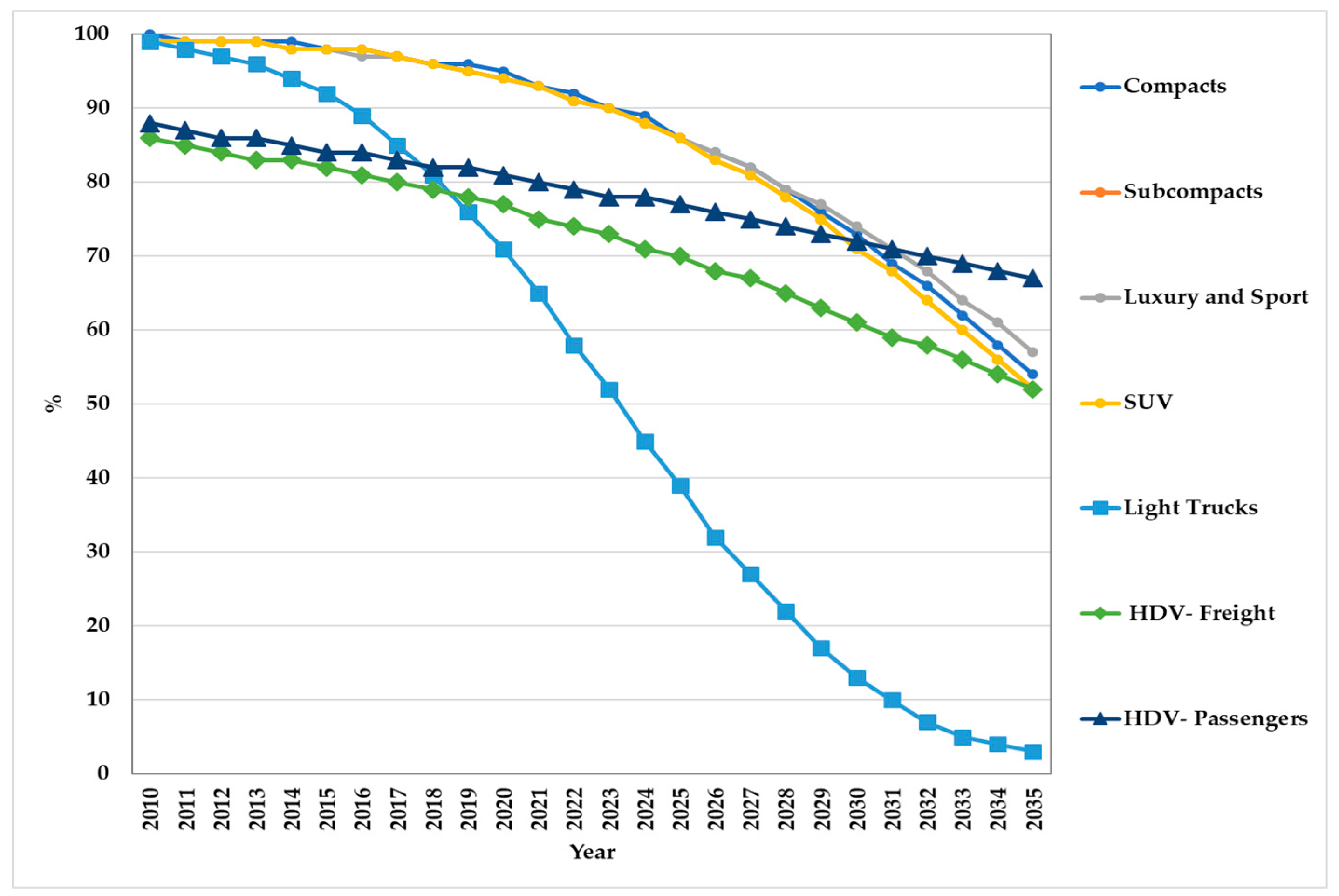
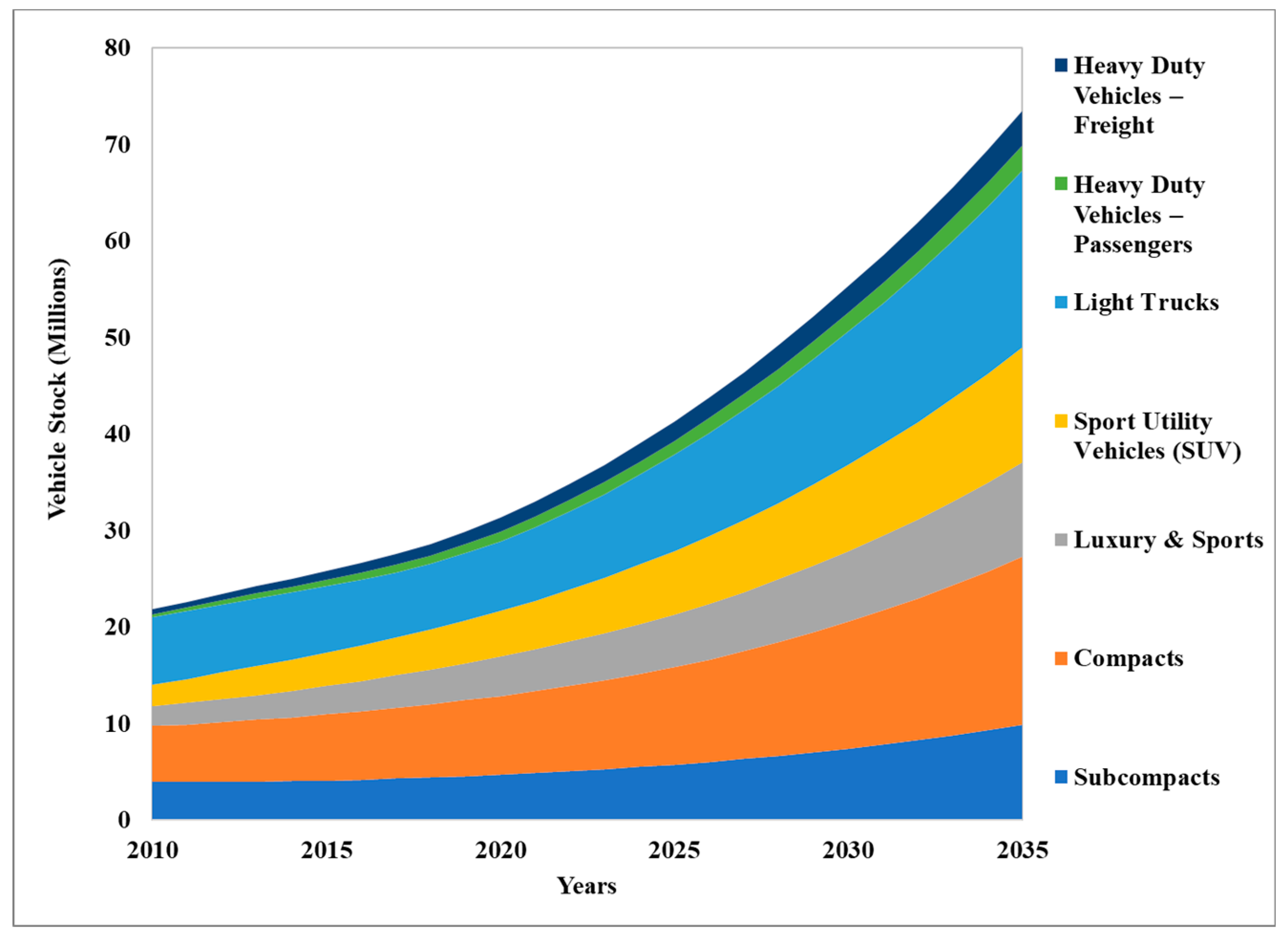
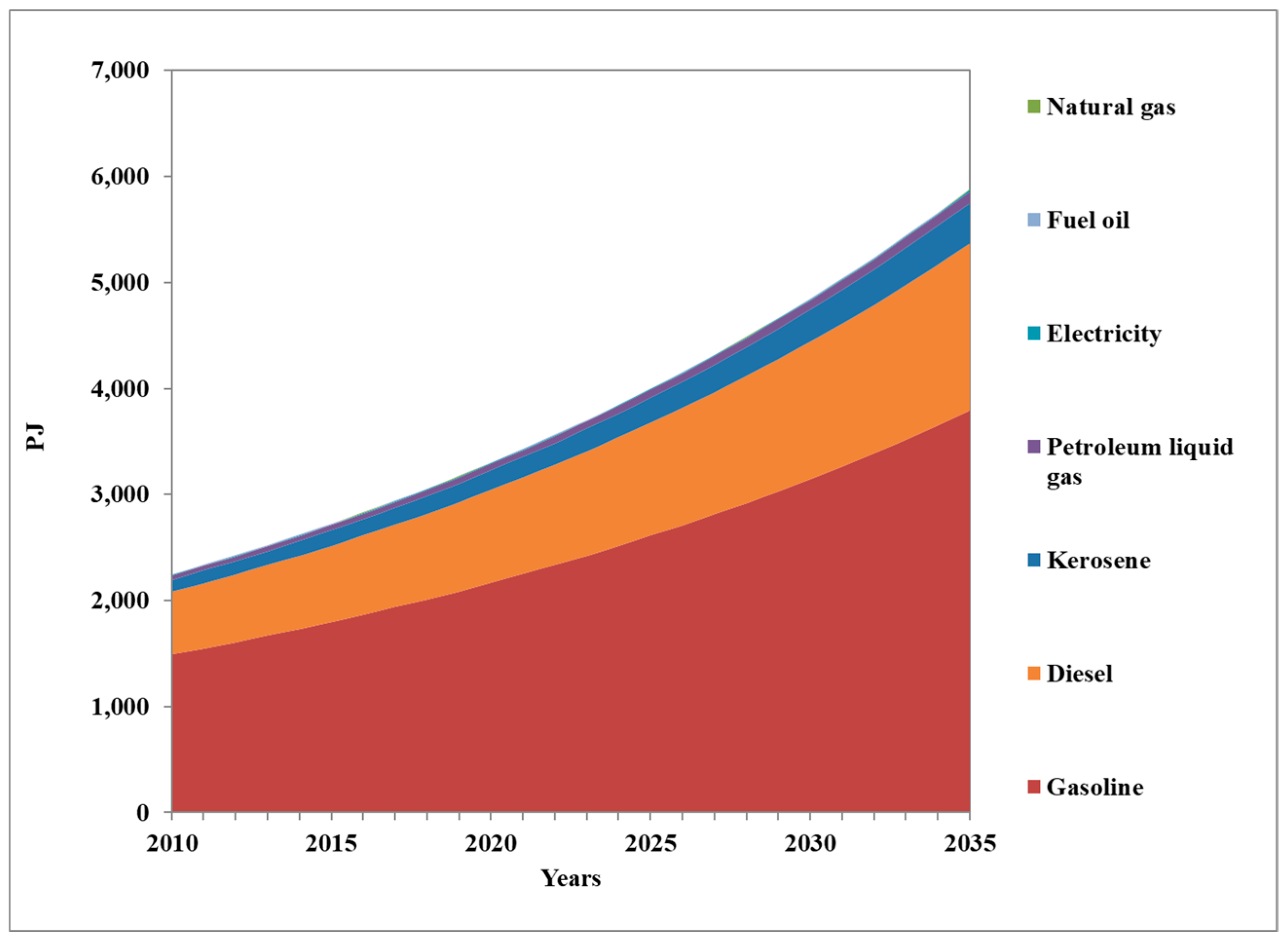
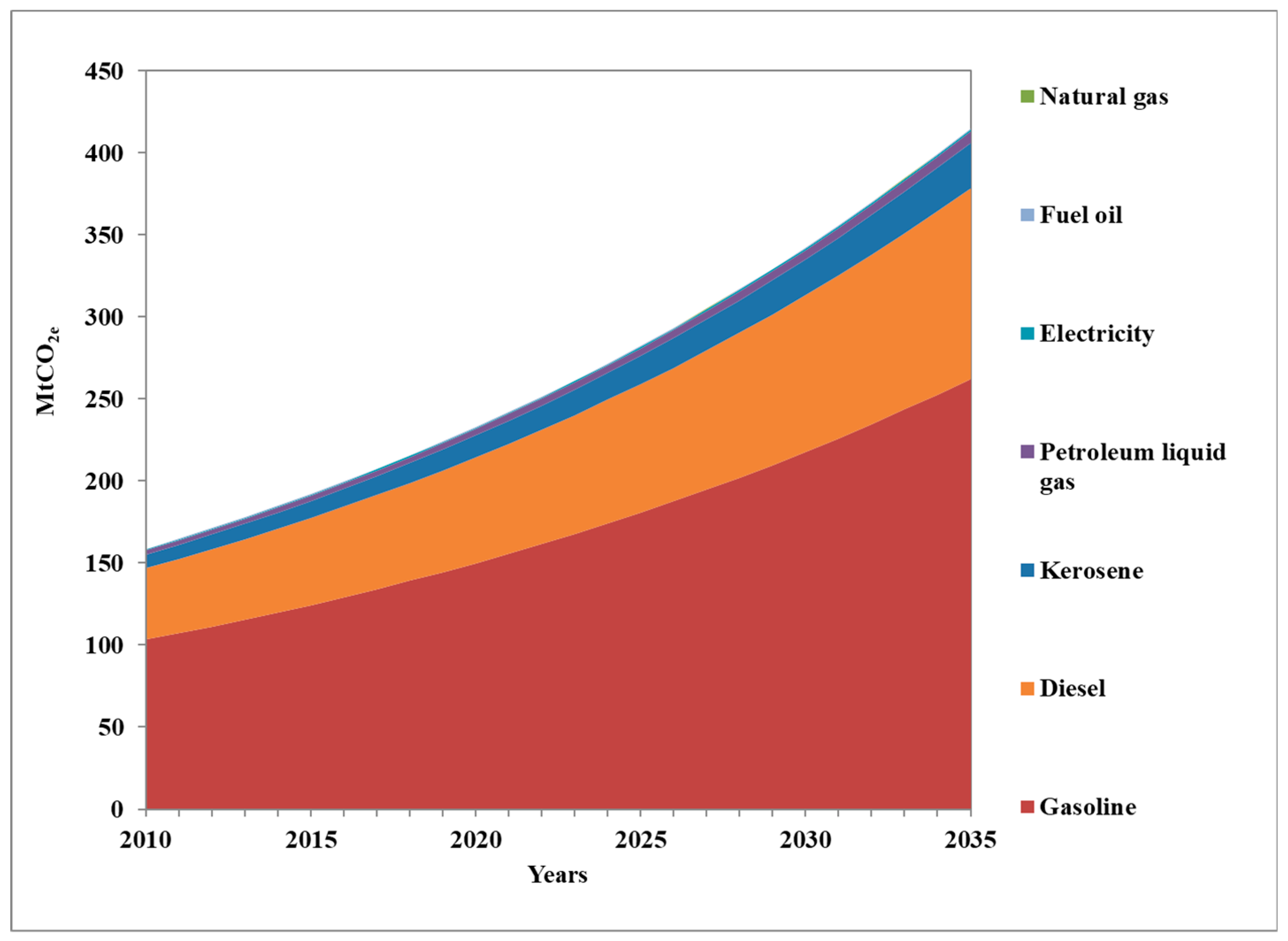
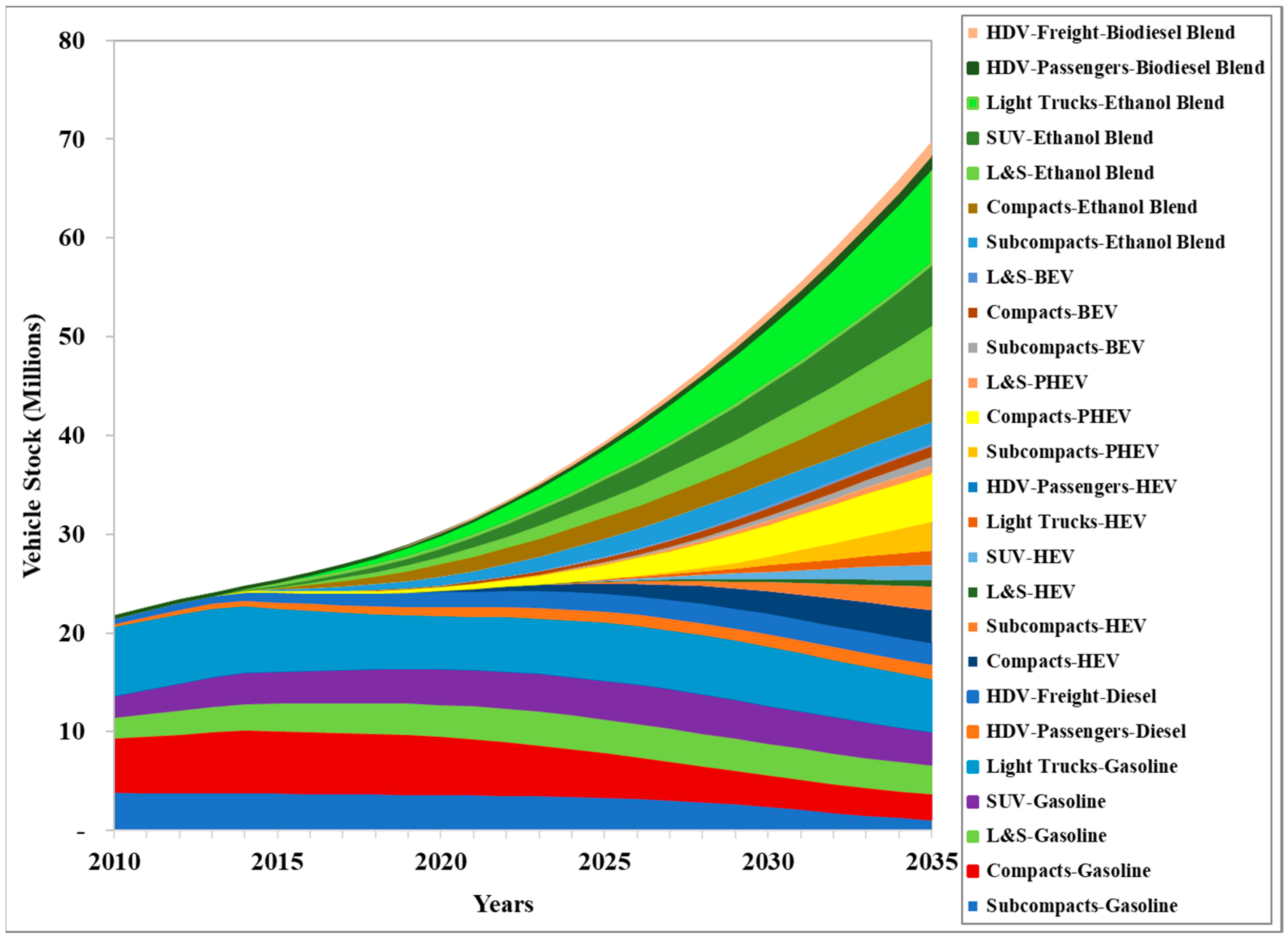
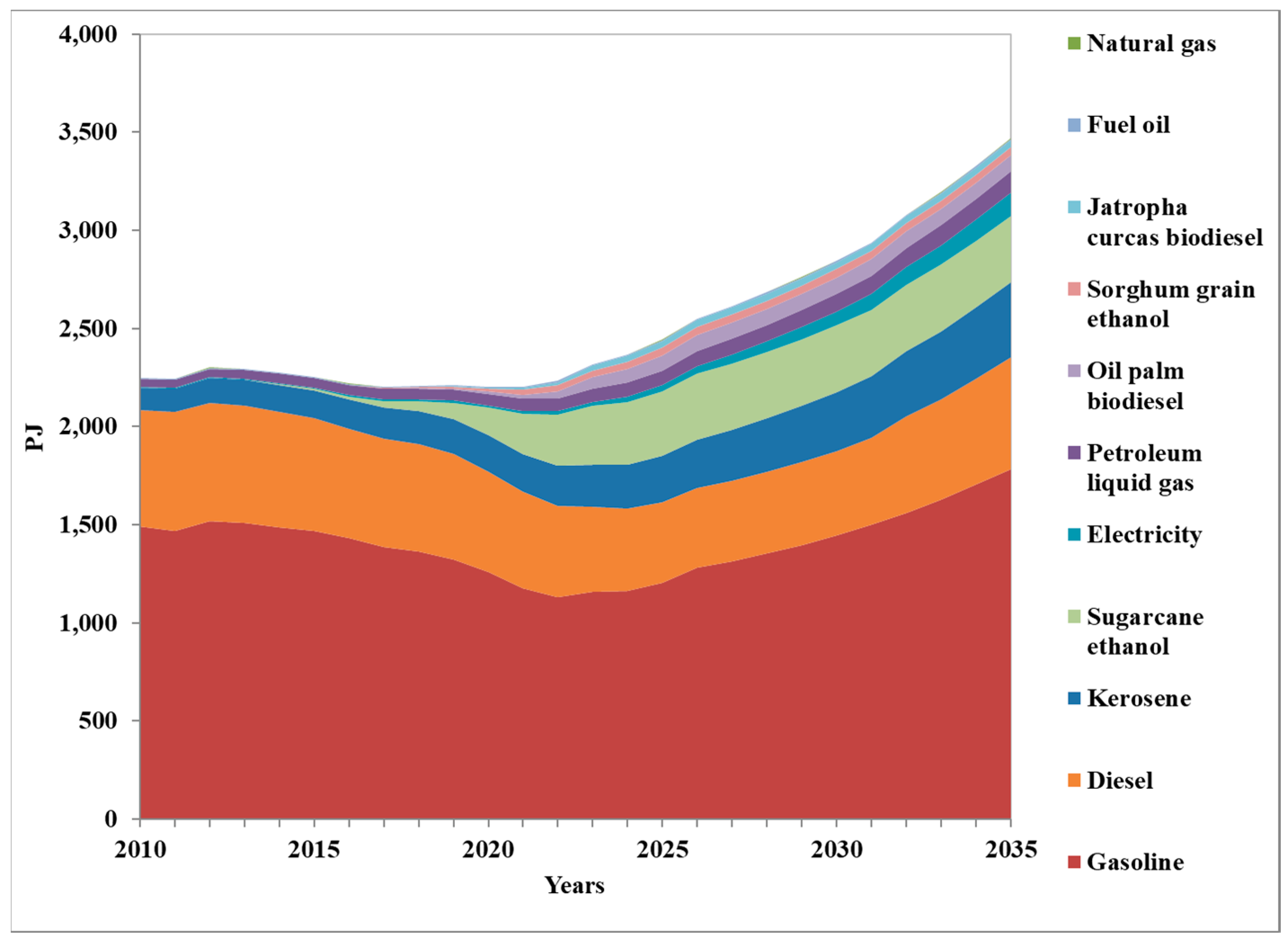
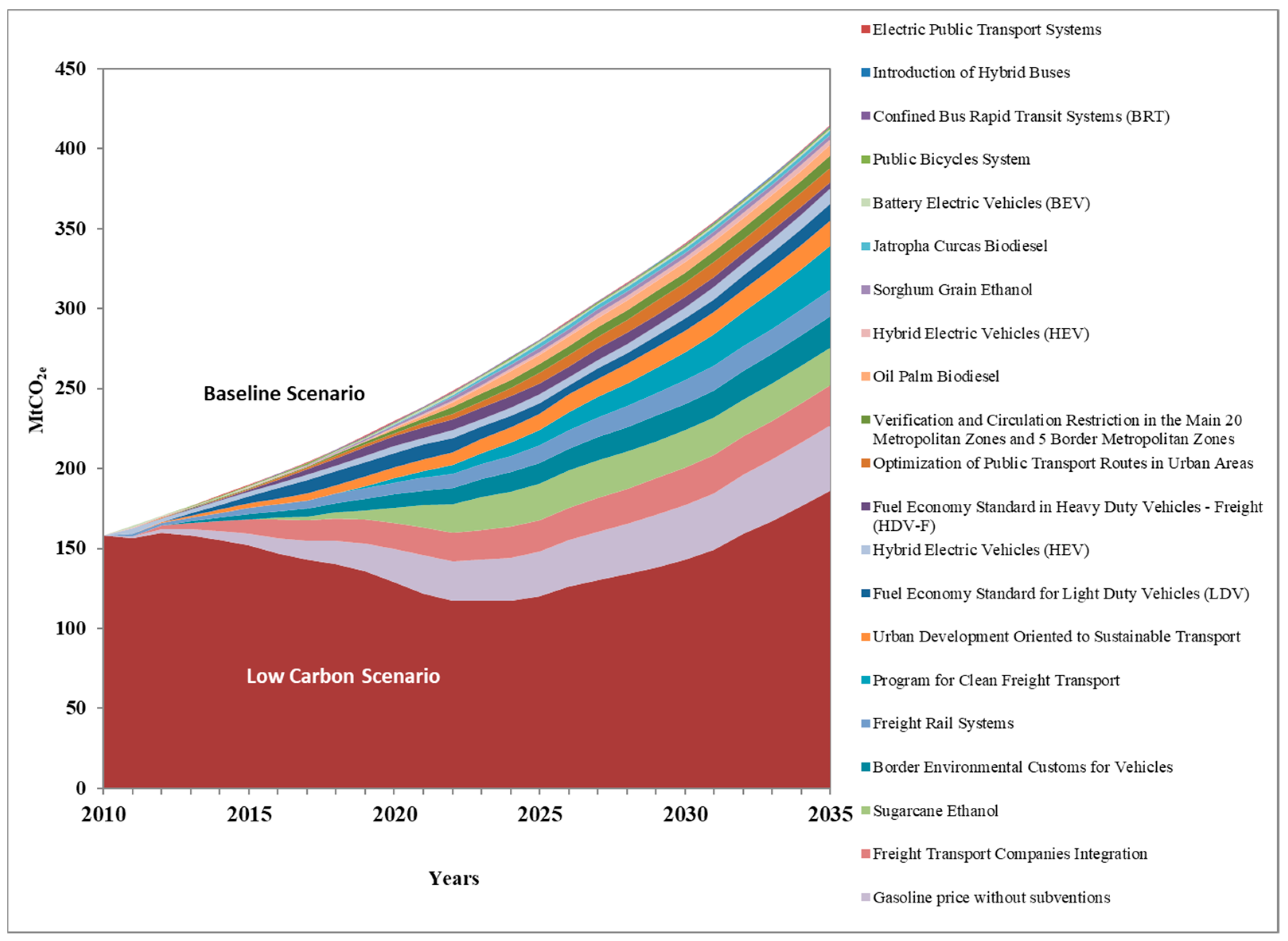
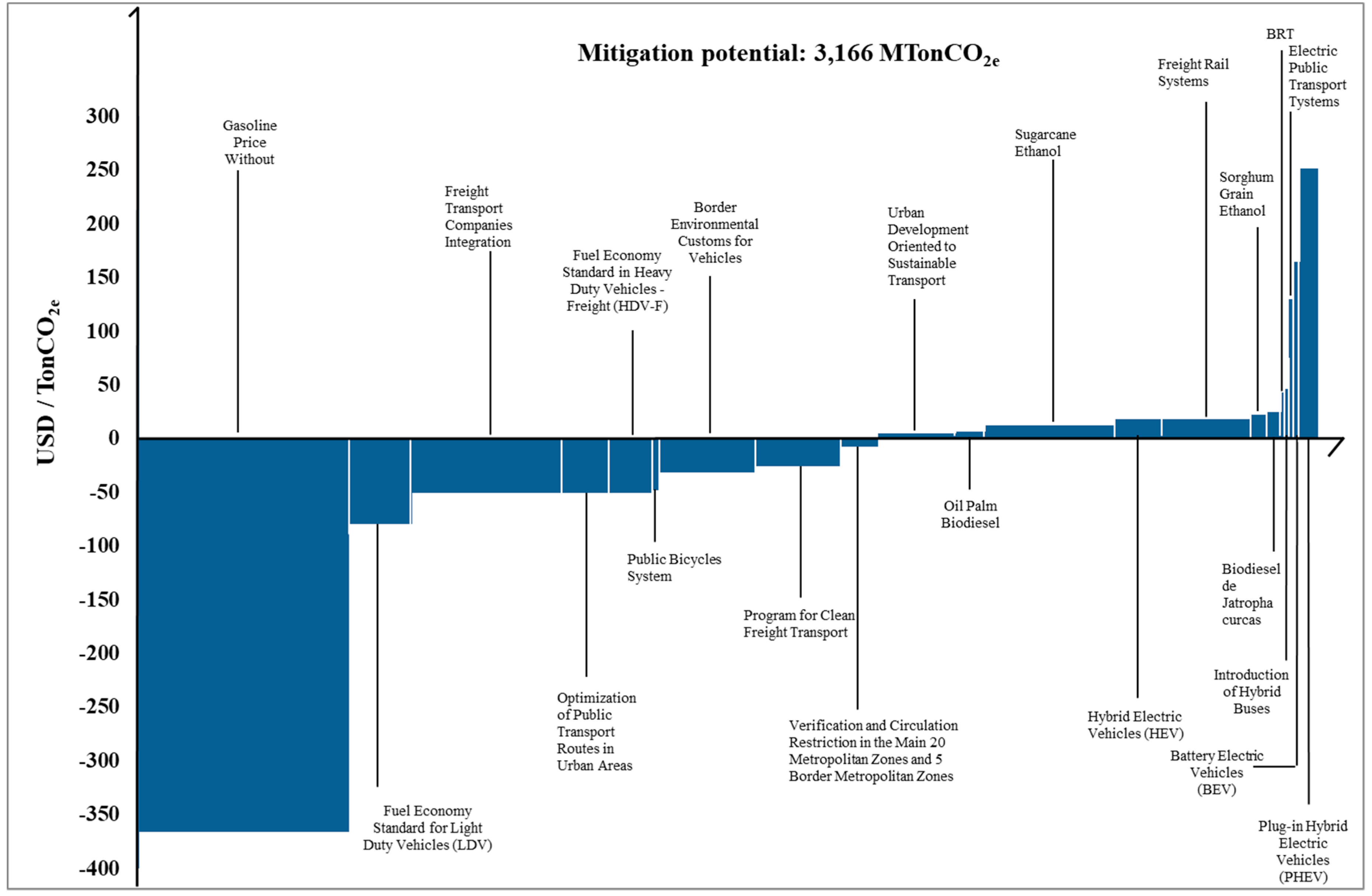
| Country (World Ranking GHG From Transport Sector) * | GHG Transport Sector Emissions, 2014 * (MtCO2) | GHG Road Transport/ GHG Total Transport Emissions, 2010 ** | Scenarios | Measures | 2035 GHG Reduction from Baseline or Base Year (MtCO2e) | 2035 GHG Reduction from Baseline or Base Year | Prospective Country Studies |
|---|---|---|---|---|---|---|---|
| USA (1) | 1,729 | 79% | 2 | 7 | 1,595 | 56% | [4] |
| CHINA (2) | 781 | 64% | 7 | 11 | 335 | 44% | [5] |
| INDIA (3) | 232 | 83% | 2 | 5 | 346 | 51% | [6] |
| GERMANY (8) | 155 | 78% | 3 | 7 | 148 | 88% | [7] |
| Fuel | USD/GJ | Own Data Based on: |
|---|---|---|
| Gasoline | 19.0 | [29] |
| Diesel | 16.5 | [30,31] |
| Fuel oil | 11.2 | [30,31,32] |
| Natural Gas (NG) | 5.1 | [33] |
| Liquid Petroleum Gas (LPG) | 20.9 | [29,31,34] |
| Electricity | 30.6 | [28] |
| Vehicle Type | Millions |
|---|---|
| Compacts (gasoline) | 5.7 |
| Subcompacts (gasoline) | 4.0 |
| Luxury & Sport (gasoline) | 2.1 |
| Sport Utility Vehicles (SUV) (gasoline) | 2.2 |
| Light Trucks (gasoline) | 7.0 |
| Heavy Duty Vehicles-Freight (HDV-F) (diesel) | 0.5 |
| Heavy Duty Vehicles-Passengers (HDF-P) (diesel) | 0.3 |
| Vehicle Type | 2010 | 2035 | AAGR |
|---|---|---|---|
| (km/lt) | (%) | ||
| Compacts | 7.0 | 9.0 | 1.0 |
| Subcompacts | 9.6 | 15.1 | 1.9 |
| Luxury and Sport | 6.7 | 8.7 | 1.0 |
| SUV | 5.5 | 7.1 | 1.0 |
| Light Trucks | 5.5 | 5.9 | 0.3 |
| HDV-F | 3.3 | 7.7 | 3.4 |
| HDV-P | 3.3 | 7.4 | 3.3 |
| Vehicle Type | 2010 * | 2035 | AAGR |
|---|---|---|---|
| (km/year) | (%) | ||
| Compacts | 11,290 | 14,964 | 1.10% |
| Subcompacts | 11,052 | 15,626 | 1.40% |
| Luxury and Sport | 11,964 | 15,631 | 1.10% |
| SUV | 12,378 | 15,804 | 1.00% |
| Light Trucks | 12,218 | 15,229 | 0.90% |
| HFV-F | 65,557 | 49,977 | −1.10% |
| HDV-P | 55,438 | 41,096 | −1.20% |
| Fuel Type | (tCO2/TJ) |
|---|---|
| Gasoline | 68.6 |
| Diesel | 73.3 |
| Liquid Petroleum Gas (LPG) | 62.7 |
| Natural Gas (NG) | 55.8 |
| Fuel oil | 72.5 |
| Kerosene | 72.5 |
| Bicycle Passenger Sources | |
|---|---|
| Original Transport Mode | Trips Share |
| Private car (sedan) | 20% |
| Bus | 26% |
| Taxi | 15% |
| Non-motorized transport | 19% |
| Not from other transport (new trips) | 20% |
| Urban Indicators | Daily Trips Per Person | Average Distance Per Trip |
|---|---|---|
| Population density | −0.199 | −0.101 |
| Mixed land use index | 0.337 | −0.177 |
| Jobs per house | - | 0.106 |
| Employment-workers balance | −0.336 | - |
| Sugarcane Ethanol | Sorghum Grain Ethanol | Units | Jatropha curcas Biodiesel | Palm Oil Biodiesel | Units | |
|---|---|---|---|---|---|---|
| Technical Assumptions | ||||||
| Surface Required | 2.9 | 2.6 | Mha | 3.2 | 1.85 | Mha |
| Crop Yield | 64 | 2.6 | t/ha | 0.7 | 1.5 | t/ha/year |
| Load Factor | 0.85 | 0.80 | - | 0.82 | 0.82 | - |
| Plant Capacity (One Plant) | 170 | 190 | ML/plant-year | 93,750 | 140,171 | t seed or fruit/year |
| Annual Production | 145 | 152 | ML/plant | 37.5 | 41.6 | ML |
| Industrial Performance | 83.2 | 396.0 | L/t sugarcane or sorghum grain | - | - | - |
| Number of Plants | 139 | 28 | - | 29 | 117 | - |
| Transesterification Efficiency | - | - | - | 97% | 97% | - |
| Cost Structure (one plant) | ||||||
| Investment | $ 56.9 | $ 70.4 | MUSD | $ 25.9 | $ 25.9 | MUSD |
| O & M | $ 7.91 | $ 10.0 | MUSD/year | $ 0.38 | $ 0.38 | MUSD/year |
| Raw Material | $ 28.2 | $ 224.0 | USD/ton | $ 397.0 | $ 313.4 | USD/ton |
| Vehicle Category | Vehicle Type | BLS AAGR 2010–2035 (%) | Historical AAGR 1990–2010 (%) * |
|---|---|---|---|
| Motor vehicles | Compacts, subcompacts, L&D and SUV | 5.1 | 6.0 |
| Passenger buses | Heavy Duty Vehicles-Passengers | 8.6 | 6.2 |
| Light Trucks and Heavy Duty Vehicles-Freight | Light Trucks and Heavy Duty Vehicles-Freight | 4.4 | 5.7 |
| Total | - | 5.0 | 5.9 |
| Measures Category | INDIA | MEXICO | ||
|---|---|---|---|---|
| [6] | This Work | |||
| Absolute GHG Reductions | Absolute GHG Reductions | |||
| MtCO2 | % | MtCO2 | % | |
| Sustainable Mobility * | 50 | 7% | 26 | 6% |
| Freight Logistics ** | 18 | 3% | 69 | 17% |
| Fuel Economy *** | 120 | 18% | 83 | 20% |
| Biofuels **** | 18 | 3% | 35 | 8% |
| Electric Vehicles ***** | 140 | 20% | 15 | 4% |
| Total GHG Reductions from a Baseline Scenario | 346 | 51% | 229 | 56% |
| Mitigation Measure | I | M | S | CPS | AF | C-B | MC | AE |
|---|---|---|---|---|---|---|---|---|
| MUSD | USD/tCO2e | MtCO2e | ||||||
| Energy Efficiency | 35,897 | 6905 | −171,057 | 0 | −136,631 | −264,888 | −108 | 2457 |
| Fuel Economy Standard for LDV | 3085 | 0 | 0 | 0 | −16,727 | −13,642 | −79 | 172 |
| Gasoline Price Without Subventions | 0 | 0 | −171,057 | 0 | −38,175 | −209,232 | −366 | 571 |
| Verification and Circulation Restriction in the Main 20 Metropolitan Zones and 5 Border Metropolitan Zones | 0 | 4775 | 0 | 0 | −5498 | −723 | −7 | 98 |
| Fuel Economy Standard in HDV-F | 90 | 0 | 0 | 0 | −6101 | −6011 | −50 | 120 |
| Border Environmental Customs for Vehicles | 6522 | 2092 | 0 | 0 | −16,787 | −8174 | −32 | 259 |
| Optimization of Public Transport Routes in Urban Areas | 0 | 0 | 0 | 0 | −5835 | −5835 | −50 | 116 |
| Introduction of Hybrid Buses | 356 | 38 | 0 | 0 | −152 | 242 | 48 | 5 |
| Electric Public Transport Systems | 656 | 0 | 0 | 0 | −209 | 446 | 149 | 3 |
| Public Bicycles System | 544 | 0 | 0 | 0 | −1375 | −832 | −48 | 17 |
| Confined BRT Systems | 1275 | 0 | 0 | 0 | −893 | 382 | 43 | 9 |
| Program for Clean Freight Transport | 2730 | 0 | 0 | 0 | −8482 | −5751 | −25 | 226 |
| Urban Development Oriented to Sustainable Transport | 2231 | 0 | 0 | 0 | −1150 | 1081 | 5 | 210 |
| Freight Rail Systems | 18,244 | 0 | 0 | 0 | −14,018 | 4226 | 18 | 236 |
| Freight Transport Companies Integration | 164 | 0 | 0 | 0 | −21,229 | −21,065 | −51 | 415 |
| Liquid Biofuels | 3048 | 35,912 | 0 | −3662 | −28,487 | 6814 | 13 | 514 |
| Sugarcane Ethanol | 2371 | 24,984 | 0 | −1930 | −20,928 | 4498 | 13 | 355 |
| Sorghum Grain Ethanol | 369 | 4576 | 0 | −1500 | −2497 | 949 | 22 | 43 |
| Jatropha curcas Biodiesel | 232 | 2340 | 0 | −202 | −1519 | 852 | 24 | 35 |
| Oil Palm Biodiesel | 76 | 4012 | 0 | −30 | −3543 | 515 | 6 | 82 |
| New Electric Mobility Technologies | 25,559 | 0 | 0 | 0 | −8258 | 17,302 | 89 | 194 |
| Hybrid Electric Vehicles (HEV) | 6297 | 0 | 0 | 0 | −4047 | 2250 | 18 | 127 |
| Plug-in Hybrid Electric Vehicles (PHEV) | 13,218 | 0 | 0 | 0 | −1922 | 11,296 | 251 | 45 |
| Battery Electric Vehicles (BEV) | 6044 | 0 | 0 | 0 | −2289 | 3756 | 163 | 22 |
| Totals | 64,504 | 42,817 | −171,057 | −3662 | −173,376 | −240,772 | −76.05 | 3166 |
© 2019 by the authors. Licensee MDPI, Basel, Switzerland. This article is an open access article distributed under the terms and conditions of the Creative Commons Attribution (CC BY) license (http://creativecommons.org/licenses/by/4.0/).
Share and Cite
Islas-Samperio, J.M.; Manzini, F.; Grande-Acosta, G.K. Toward a Low-Carbon Transport Sector in Mexico. Energies 2020, 13, 84. https://doi.org/10.3390/en13010084
Islas-Samperio JM, Manzini F, Grande-Acosta GK. Toward a Low-Carbon Transport Sector in Mexico. Energies. 2020; 13(1):84. https://doi.org/10.3390/en13010084
Chicago/Turabian StyleIslas-Samperio, Jorge M., Fabio Manzini, and Genice K. Grande-Acosta. 2020. "Toward a Low-Carbon Transport Sector in Mexico" Energies 13, no. 1: 84. https://doi.org/10.3390/en13010084
APA StyleIslas-Samperio, J. M., Manzini, F., & Grande-Acosta, G. K. (2020). Toward a Low-Carbon Transport Sector in Mexico. Energies, 13(1), 84. https://doi.org/10.3390/en13010084






